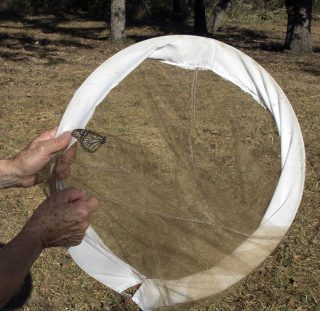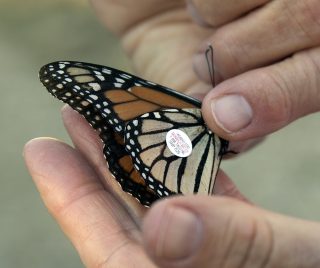
Capturing a Monarch is fairly easy if you use a butterfly net. Sweep the net horizontally and allow the butterfly to go to the deep end of the net. It is best to flip the end of the net bag over the net rim to keep the butterfly from fluttering and damaging its wings. Robert Benson Photo.
11 Nov 2016 – Goodbye and Good Luck, Number 525
Wow! We caught one! The Monarch Butterfly in the net was on its way south when we nabbed it on October 17th. This fall we are participating in a Monarch marking program. Now that we had a butterfly-in-hand, we were to mark it with an identifying number, as is done in banding birds. But how do you band a butterfly?
Well, you don’t put an aluminum band around its leg, that’s for sure! Instead, a numbered sticker is affixed to the underside of the hindwing, the data recorded, and the butterfly released.
We purchased a tagging kit from MonarchWatch.com earlier in the fall. It contained 25 numbered stickers, instructions, and a data sheet. The idea was to capture Monarchs migrating through our part of Texas to help answer lingering questions about these butterflies’ spectacular journeys.

This Monarch Butterfly was captured and tagged with a MonarchWatch numbered sticker on October 17th. With luck, Number 525 will reach the Oyamel fir forest in central Mexico where it will overwinter. Robert Benson Photo.
We have known since 1975 where they go: To the Oyamel fir forests in the mountains of central Mexico. We know that the individuals that migrate to these forests overwinter in huge clusters in the boughs of the trees. They live off the stored fat reserves in their abdomens. On warm (above 55F), sunny days, small groups descend a mile or so down the mountains to get water at streams. While they are drinking, the Monarchs close their wings, making the tagged butterflies easy to pick out amongst their untagged brethren. Local villagers collect as many as they can (which is not many) and sell the recovered tags to researchers for 50 pesos apiece.
Fifty pesos is only about $5 in US currency but it goes a long way to help reimburse the villagers for their efforts and encourage them to protect the Monarchs’ wintering grounds. Most of the $15 we pay for each tagging kit goes to the local inhabitants of the Oyamel forests for the recovery of the tags. Even if we did not get any other value from the tagging program, I think giving the villagers some income for Monarch conservation is important.
Actually, we do learn a lot from these tagging programs. Gayle Steffy, a citizen scientist in Pennsylvania, recently published the results of an 18-year tagging study. Of the 11,333 Monarchs she marked, 56 were recovered in Mexico. That is a recovery rate of one butterfly for every 200 tagged. That may not seem like much, but it is really a very good rate of return, considering that these fragile insects travelled almost 2,000 miles from their birthplace.
Steffy’s data showed that early migrating butterflies were more likely to reach the wintering grounds. Those that left Pennsylvania between 20 August to 9 September were more successful than “middle migrants” (10 September-1October) and that no late migrants (2 October-20 October) were recovered at all.
Collisions with vehicles, predation, and bad weather are all hard on the migrating Monarchs. By far the biggest threats to the Monarchs in the Oyamel forests are winter storms. A storm that began with 48 hours of rain on January 12, 2002, killed an estimated 80% of the overwintering population. We know this because the villagers were able to recover tags from the dead butterflies on the ground. These sorts of weather events are rare but happen every few years. Coupled with habitat loss, milkweed eradication, and possibly climate change, the Monarch Butterfly population is indeed in danger.
Tagging research indicates that butterflies from as far north as Winnipeg, Canada (50 degrees North latitude), have made the long trip. Migratory Monarchs are in a special physiological state. Most individuals hatching out after the summer solstice do not produce the hormone necessary for reproductive development and are thus in a state of “suspended reproduction” , or diapause. Only these butterflies in diapause migrate. Any late summer butterflies still breeding and laying eggs do not join the migration.
The non-reproductive Monarchs stay in diapause until mid-February when they are about to leave the Mexican forests on their way northward. Sexual activity on the wintering grounds ensures that all portions of the population have a chance to meet and mate. This means there is complete genetic mixing among Monarchs. The resulting high degree of genetic variability is good for health of the species.
The now-reproducing Monarchs move northward, mating and laying eggs as they go. After exhausting themselves with the breeding and migrating, these individuals die. Because of the diapause they have lived 8 to 9 months, and thus may be the longest-lived of all butterflies. The subsequent generations produced in the spring and summer live only two to five weeks. Consequently, the butterflies reaching the breeding grounds in the northeastern US and Canada are three and four generations beyond their great-great grandparents who went south the previous fall. Tagging across the Monarchs’ range has revealed amazing details about these insects.
That’s why we decided to mark Monarchs here in South Texas. But so far, we have only marked one: Number 525. He is well on his way to the Oyamel forests, we hope. By one estimate, Monarchs travel 34 miles a day in Texas, so Number 525 should be just southeast of Monterrey, Mexico today. Three hundred miles to go, Number 525. We wish you good luck and God speed!
If you would like to offer comments, please click through to the discussion page
